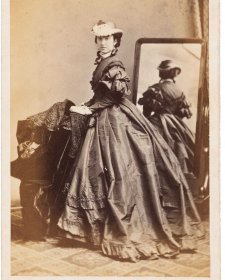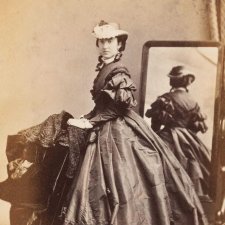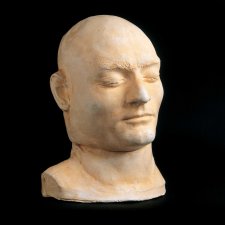George Case (life dates unknown) and his wife Grace Egerton (d. 1881), variety performers, made several successful tours of Australia in the 1860s and 1870s. They appeared first in Melbourne in September 1864. Mrs Case, the star of the duo, immediately impressed audiences with her impersonations, singing, dancing, dextrous changes of costume and prestidigitation in the persona of ‘The Wizard of the East’. Mr Case’s turns on violin and accordion were also applauded. In December 1864 they played before Governor and Lady Darling, and every seated lady received a carte de visite of Mrs Case by Alexander Fox. Mr Case filled the gaps in her performances with turns on the violin and accordion. In August 1865, in Brisbane, she appeared in fifteen different roles on one night. In 1867 she appeared as the tenor, Sims Reeves, in Hobart; in January 1868 she took on three separate characters in ‘A Scene in a London Restaurant’. In Harrogate, Yorkshire in 1870 she starred as Mrs Major Buster, formidable mother-in-law, and Miss Judith Clench, ‘the determined advocate of woman’s rights’. In September 1875 they were in Brisbane performing ‘Latest Intelligence’ in which Egerton assumed numerous identities, ‘the rapid transition from one to another is never allowed to interfere’, wrote the courier, ‘the short period necessarily intervening between the assumption of each character being effectively filled up by Mr Case, whose performances on the violin and English concertina never failed to draw forth hearty manifestations of approbation.’ Mr and Mrs Case were still drawing favourable reviews in 1879 in Canada, where Mrs Case died in 1881.
Alexander Fox came to Victoria in the early 1850s seeking to make his fortune on the goldfields. His efforts mustn’t have amounted to all that much, for by early 1856 he was working as a photographer in Bendigo. In May 1857, the Bendigo Advertiser took ‘much pleasure in noticing the beautiful artistic display of Collodion, Daguerreotype, Calotype, and other portraits, to be seen at the rooms of Mr. Alexander Fox.’ The same year he produced what is described as the earliest known photographic record of early Bendigo. Fox also travelled to other goldfields, taking mining photographs. In 1858 he was declared insolvent. Returning to Melbourne, he worked from ‘photographic rooms’ at various addresses: 67 Collins Street, then 75 Swanston Street between 1864 and 1866 and then Collins Street again. These ventures also failed, forcing Fox to seek financial assistance from his brothers-in-law. Eventually, they made their financial assistance conditional on him removing himself from their lives. Fox was in Sydney during 1867 and 1868 and then left for San Francisco in 1868. On his death in 1882 he was living and working in Salt Lake City. The second-youngest of the seven children he had with his wife Rosetta Phillips was the painter Emanuel Phillips Fox.
Collection: National Portrait Gallery
Purchased 2010



On one level The Companion talks about the most famous and frontline Australians, but on another it tells us about ourselves.



Drawn from the NPG’s burgeoning collection of cartes de visite, Carte-o-mania! celebrates the wit, style and substance of the pocket-sized portraits that were taken and collected like crazy in post-goldrush Australia.



Death masks, post-mortem drawings and other spooky and disquieting portraits... Come and see how portraits of infamous Australians were used in the 19th century.